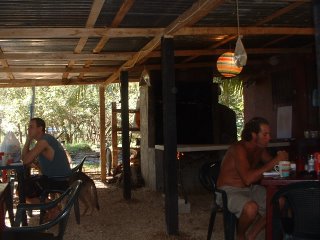 One of the most interesting people we met in Costa Rica was a waitress. In reality, she was much more, but we got to know her as a food server in one of Playa Tamarindo’s best restaurants.
One of the most interesting people we met in Costa Rica was a waitress. In reality, she was much more, but we got to know her as a food server in one of Playa Tamarindo’s best restaurants.Her name is Olivia. She is mid to late 30’s, slim, attractive, very professional in her work and obviously quite intelligent. The evening of our offshore fishing excursion, when we brought our freshly caught Tuna to Gecko’s at Iguana Surf for our dinner preparation, she was the one who waited on us.
(In checking through my trip photos we must not have taken one of Olivia; hopefully my cousin Jim will have one among their pictures. If so, I’ll add it to this blog post at a later date.)
Olivia grew up in upstate New York and, in contrast to everyone in her family, was always on the go. She loved new places and new experiences and in fact was turned on by the freshness of change. New venues became commonplace.
Late In her twenties, she ended up in the Big Apple as a successfully rising young business professional. Her days consisted of awaking early, spending long days at the office and then coming home late in the evening to a TV dinner before crashing and doing it all over again the next day.
We had asked her what had brought her to Costa Rica. She related the tale of grooving into her fast-paced career in New York City, but she pointed out that she found her life style to be less than enjoyable. One morning while getting ready for another day in the grind, she looked in the mirror and said out loud, “WHAT are you doing?”
Soon thereafter Olivia quit her job and decided to set out for parts unknown, much to the chagrin of her family. She pulled out a world map, closed her eyes and pointed. Her finger landed on Costa Rica. A month later she was living the good life in one of the most beautiful places on earth.
She found the Tico life style much to her liking. A hard worker, she soon was gainfully employed, saving money, and making friends. She loved the laid back life style and the incredible surfing environment of Playa Tamarindo. That must be why she was tanned so darkly.
Does she have any regrets? None, whatsoever, she says. And now her business training and entrepreneurship tendencies are beginning to flower in the tropics. With money she had saved, she and two partners had just opened a little breakfast café right on the beach. I believe it was called “Morning Grinds” (as in coffee and surfing?) or something closely catchy. The picture above was taken in their new venture at which we stopped for our last meal in Tamarindo before driving back to Liberia.
Olivia left it all for “pura vida” in Guanacaste Province. She's been there about three years now. And I’ve got a feeling it’ll be a long time, if ever, before she goes back to New York City.













